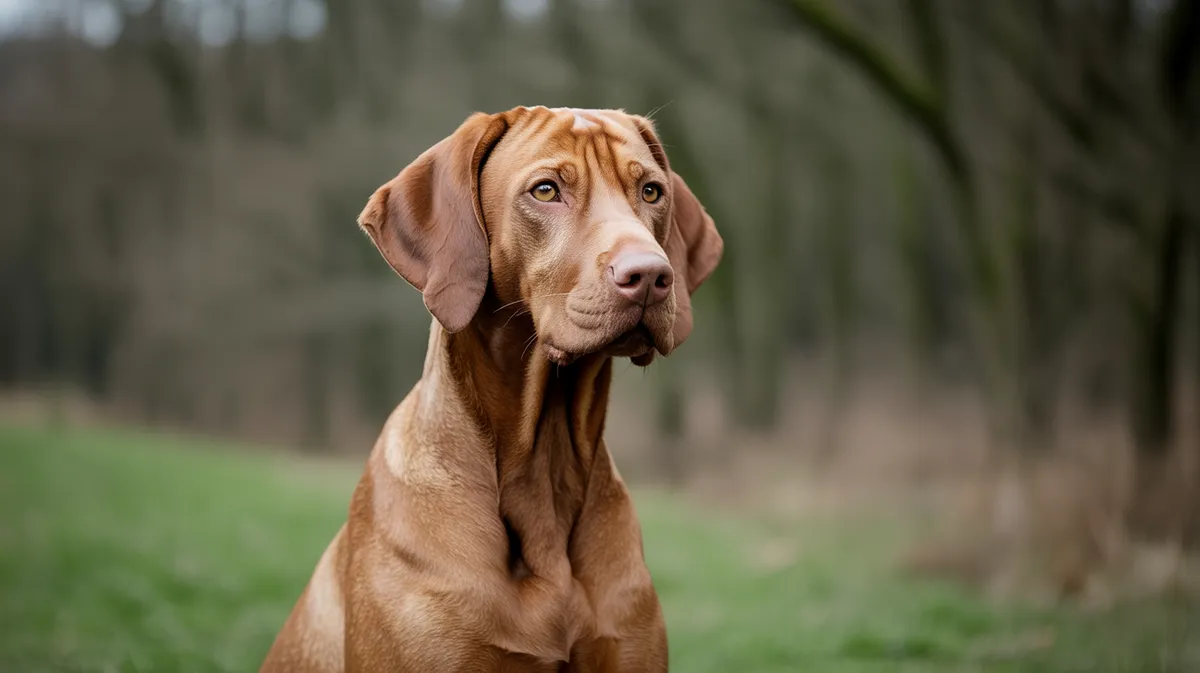
Vizsla
Canis lupus familiaris

Meet the Vizsla
The Vizsla is a medium-sized hunting dog breed originating from Hungary, known for its sleek rust-colored coat and athletic build. Bred primarily as a pointer and retriever, Vizslas are highly energetic, intelligent, and affectionate, making them excellent companions for active families. Their keen sense of smell and innate trainability have made them popular in both hunting and various dog sports. Vizslas thrive on human companionship and can develop strong bonds with their owners, often displaying a gentle and sensitive temperament.
Classification
Mammal
Habitat
Domestic; originally open fields, grasslands, and forests
Diet
Omnivore
Lifespan
12-15 years
Conservation
Least Concern
Weight
20-30 kg (44-66 lbs)
📖Fascinating Facts
Ancient Breed
The Vizsla's lineage can be traced back over a thousand years, making it one of the oldest sporting dog breeds in Europe.
Natural Swimmer
Vizslas possess webbed feet, which help them swim efficiently and retrieve game from water.
Family Companion
Known for their gentle and affectionate nature, Vizslas are excellent family dogs and thrive on companionship.
📋Detailed Description
The Vizsla is a medium-sized, short-coated sporting dog, typically weighing between 20–30 kg (44–66 lbs) and standing 53–64 cm (21–25 in) at the shoulder, with males generally larger than females. Its lean, muscular build and deep chest reflect its origins as a versatile hunting dog, capable of sustained speed and agility over varied terrain. The breed is characterized by a distinctive golden-rust coat, which is dense, smooth, and close-lying, providing some protection against brush and weather but minimal insulation against cold. Vizslas have a moderately long, square muzzle, well-developed nostrils, and expressive, almond-shaped eyes, contributing to their keen sense of smell and acute vision. Their ears are long, thin, and set low, aiding in scent detection. Behaviorally, Vizslas are known for their high energy, intelligence, and affectionate nature, often forming strong bonds with their human families. They are highly trainable, excelling in obedience, agility, and scent-based tasks, and require significant daily physical and mental stimulation. Socially, Vizslas are generally friendly with other dogs and people, but can be sensitive to harsh training methods or prolonged isolation. Reproduction in Vizslas follows typical canine patterns, with litters averaging 6–8 puppies and attentive maternal care. Unique adaptations include their stamina, webbed feet for swimming, and a strong prey drive, making them adept at both pointing and retrieving game in diverse environments.
💡 Did you know?
The Vizsla is one of the oldest known pointer-retriever breeds, with references dating back to the 10th century in Hungary.
🔬Research & Sources
Wikipedia Summary
The Vizsla, also known as Hungarian Vizsla, Magyar Vizsla or Hungarian Pointer, is a dog breed from Hungary and belongs to the Fédération Cynologique Internationale (FCI) group 7, the Canadian Kennel Club (CKC) group 1, and the American Kennel Club. The Hungarian or Magyar Vizsla or Smooth-Haired Vizsla are sporting dogs and loyal companions. The Vizsla's medium size is one of the breed's most appealing characteristics. As a hunter of fowl and upland game, the Vizsla has held a prominent position among sporting dogs – that of household companion and family dog.
Last Modified: 5/23/2025
🎭Behavior & Social Structure
Vizslas display a pronounced need for activity and companionship, often described as 'velcro dogs' due to their tendency to stay close to their owners. They are diurnal, most active during daylight hours, and thrive on structured routines involving exercise, play, and training. In hunting contexts, Vizslas use a combination of scent and sight to locate and indicate game, freezing in a characteristic 'point' stance with one foreleg raised. Their soft mouths allow them to retrieve game without damage. Socially, they are generally tolerant and playful with other dogs and children, though early socialization is important to prevent shyness or overexuberance. Vizslas may develop separation anxiety if left alone for extended periods, manifesting as destructive behavior or vocalization. Their feeding behavior is typical of domestic dogs, requiring a balanced diet to support their high energy expenditure.
👶Reproduction & Life Cycle
Vizslas reach sexual maturity at around 10–12 months, though responsible breeding is typically delayed until at least 18–24 months to ensure physical maturity. The breed does not have a defined breeding season, as domestic dogs can cycle year-round, but most breeders plan litters in spring or early summer. The estrous cycle lasts approximately 21 days, with ovulation occurring around day 11–14. Gestation averages 63 days, after which litters of 6–8 puppies are common. Females exhibit strong maternal instincts, providing extensive care, warmth, and grooming for the first 3–4 weeks. Puppies are weaned by 6–8 weeks and benefit from early socialization and exposure to varied stimuli. Males do not participate in parental care.
🛡️Adaptations & Survival
Vizslas possess several adaptations for their historical role as versatile hunting dogs. Their streamlined, muscular bodies and long legs enable sustained running and agility over open fields and rough terrain. The short, dense coat minimizes snagging in underbrush while providing some weather resistance. Webbed toes enhance swimming ability, allowing them to retrieve waterfowl. Their acute olfactory senses, supported by large nasal passages and a well-developed brain olfactory bulb, make them exceptional scent trackers. Behaviorally, their intelligence and eagerness to please facilitate complex training, while their strong social drive ensures close cooperation with human handlers. The breed's sensitivity to tone and mood is an adaptation to working closely with people, though it also means they respond best to positive reinforcement.
📚Research Sources
🎨Cultural Significance
The Vizsla is a national treasure in Hungary, with historical records dating back to the 10th century, where Magyar tribes used similar dogs for hunting. The breed is celebrated in Hungarian art, literature, and folklore, symbolizing loyalty, nobility, and agility. Vizslas accompanied Hungarian nobility on hunts and were considered status symbols. During the 20th century, the breed nearly faced extinction due to wars and political upheaval, but dedicated breeders preserved its lineage. Today, Vizslas are popular worldwide as hunting companions, family pets, and competitors in canine sports. Their image is often used to represent Hungarian heritage and sporting excellence.
🔬Recent Research & Discoveries
Recent genetic studies have clarified the Vizsla's relationships with other continental pointing breeds, confirming its distinct lineage and ancient origins. Ongoing research focuses on breed-specific health issues, particularly the genetic basis of epilepsy and hip dysplasia, with the aim of improving screening and reducing incidence through selective breeding. Behavioral studies have highlighted the breed's high trainability and sensitivity to human cues, making them valuable models for canine cognition research. Investigations into exercise physiology have demonstrated the Vizsla's exceptional aerobic capacity and recovery rates, informing best practices for training and care. Conservation genetics projects in Hungary and internationally are working to maintain genetic diversity and prevent the loss of rare bloodlines.
🎥Wildlife Videos

Beretta Jericho Vizslas Discovery Morning Session
Aron Helfinstine

A Sika hunt goes well with my Hungarian Vizsla - Oskar. Kaimanawas New Zealand
Oskar finds himself a nice Sika hind. Scenes of Oskar and the deer.
AvidHunter

Vizsla Hunting 1.
A bit of footage of a day out with my 5year old son and Vizsla Jasmine.
Abbey Cleaver

Vizsla Hunting
Abbey Cleaver

A Dog of a Run
THIS IS A HUNTING VIDEO. VIEWER DISCRETION ADVISED. Join Leigh and I as we take his Vizsla "April" for a run in search of ...
Bolt-Action Productions
🌍Habitat Information
The Vizsla typically inhabits Domestic; originally open fields, grasslands, and forests environments. Vizslas have adapted to their environments with specialized features and behaviors.
Primary Habitat:
Domestic; originally open fields, grasslands, and forests
More detailed habitat information will be available soon.
🛡️Conservation Status
The Vizsla is currently classified as Least Concern. Conservation efforts are crucial for preserving this species for future generations.
Common Threats:
- 🏠Habitat loss and fragmentation
- 🌡️Climate change impacts
- 🎯Hunting and poaching
- 🏭Human-wildlife conflict
⚠️Threats & Conservation Challenges
As a domestic breed, Vizslas are not threatened in the wild and are classified as 'Least Concern.' However, they face challenges common to purebred dogs, including genetic disorders such as hip dysplasia, epilepsy, and certain cancers. Overbreeding, especially by unregulated breeders, can exacerbate health issues and dilute breed standards. Vizslas require significant exercise and mental stimulation; without it, they may develop behavioral problems, leading to abandonment or surrender. In some regions, breed popularity has led to irresponsible ownership and increased numbers in rescue organizations. Conservation efforts focus on maintaining genetic diversity, responsible breeding, and public education regarding the breed's needs.
🔬Scientific Classification
Scientific Name
Canis lupus familiaris
Classification Hierarchy
🔍 About Taxonomic Classification
Taxonomic classification is a hierarchical system used by scientists to classify and organize living organisms based on shared characteristics and evolutionary relationships.
The system moves from broad categories (Kingdom) to increasingly specific ones, with each animal's scientific name typically consisting of its Genus and species.
📝Community Notes
Share your observations and insights about the Vizsla with our community of wildlife enthusiasts.
Join Our Community
Sign in to share your observations and connect with fellow wildlife enthusiasts.
Sign In to ContributeNo community notes yet
Be the first to share your observations about the Vizsla!
Explore Vizsla
Select a tab above to learn more about this amazing animal.
📸Photo Gallery
No photos available for this animal yet.
🌟Discover More Wildlife
Continue your journey of discovery with more fascinating animals from our database
